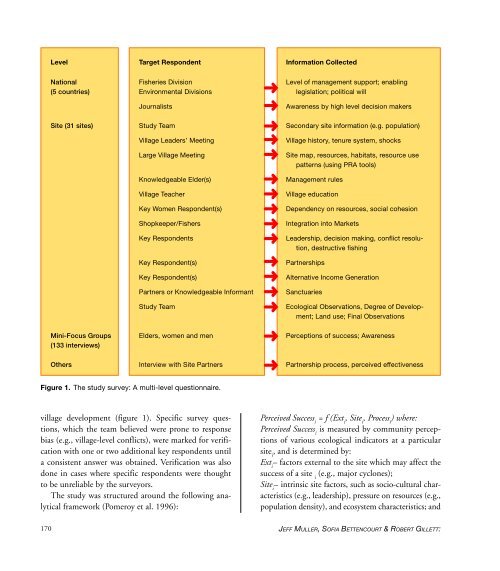You also want an ePaper? Increase the reach of your titles
YUMPU automatically turns print PDFs into web optimized ePapers that Google loves.
Level<br />
Target Respondent<br />
Information Collected<br />
National<br />
(5 countries)<br />
Site (31 sites)<br />
Fisheries Division<br />
Environmental Divisions<br />
Journalists<br />
Study Team<br />
Village Leaders’ Meeting<br />
Large Village Meeting<br />
Knowledgeable Elder(s)<br />
Village Teacher<br />
Key Women Respondent(s)<br />
Shopkeeper/Fishers<br />
Key Respondents<br />
Key Respondent(s)<br />
Key Respondent(s)<br />
Partners or Knowledgeable Informant<br />
Study Team<br />
➜<br />
➜<br />
➜<br />
➜<br />
➜<br />
➜<br />
➜<br />
➜<br />
➜<br />
➜<br />
➜<br />
➜<br />
➜<br />
➜<br />
Level <strong>of</strong> management support; enabling<br />
legislation; political will<br />
Awareness by high level decision makers<br />
Secondary site information (e.g. population)<br />
Village history, tenure system, shocks<br />
Site map, resources, habitats, resource use<br />
patterns (using PRA tools)<br />
Management rules<br />
Village education<br />
Dependency on resources, social cohesion<br />
Integration into Markets<br />
Leadership, decision making, conflict resolution,<br />
destructive fishing<br />
Partnerships<br />
Alternative Income Generation<br />
Sanctuaries<br />
Ecological Observations, Degree <strong>of</strong> Development;<br />
Land use; Final Observations<br />
Mini-Focus Groups<br />
(133 interviews)<br />
Elders, women and men<br />
➜<br />
Perceptions <strong>of</strong> success; Awareness<br />
Others<br />
Interview with Site Partners<br />
➜<br />
Partnership process, perceived effectiveness<br />
Figure 1. The study survey: A multi-level questionnaire.<br />
village development (figure 1). Specific survey questions,<br />
which the team believed were prone to response<br />
bias (e.g., village-level conflicts), were marked for verification<br />
with one or two additional key respondents until<br />
a consistent answer was obtained. Verification was also<br />
done in cases where specific respondents were thought<br />
to be unreliable by the surveyors.<br />
The study was structured around the following analytical<br />
framework (Pomeroy et al. 1996):<br />
Perceived Success i<br />
= f (Ext i<br />
, Site i<br />
, Process i<br />
) where:<br />
Perceived Success i<br />
is measured by community perceptions<br />
<strong>of</strong> various ecological indicators at a particular<br />
site i<br />
, and is determined by:<br />
Ext i<br />
– factors external to the site which may affect the<br />
success <strong>of</strong> a site i<br />
(e.g., major cyclones);<br />
Site i<br />
– intrinsic site factors, such as socio-cultural characteristics<br />
(e.g., leadership), pressure on resources (e.g.,<br />
population density), and ecosystem characteristics; and<br />
170<br />
JEFF MULLER, SOFIA BETTENCOURT & ROBERT GILLETT:


















